
XL Simpósio Brasileiro de Telecomunicações e Processamento de Sinais
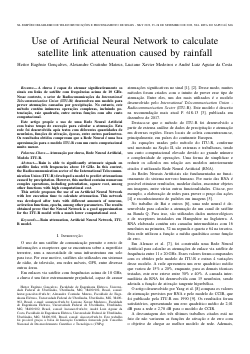
Use of Artificial Neural Network to calculate satellite link attenuation caused by rainfall
Heitor Eugênio Gonçalves, Alexandre Coutinho Mateus, Luciano Xavier Medeiros, André L. A. Costa
DOI: 10.14209/sbrt.2022.1570821541
Keywords:
Abstract
A chuva é capaz de atenuar significativamente os sinais em links de satélite com frequências acima de 10 GHz. Nesse contexto, o setor de Radiocomunicações da \textit{International Telecommunication Union} (ITU-R) desenvolveu um modelo para prever atenuações causadas por precipitação. No entanto, este método contém inúmeras operações complexas, incluindo potenciação, raiz quadrada, entre outras funções com alto custo computacional. Este artigo propõe o uso de uma Rede Neural Artificial com baixo tempo de execução para calcular a atenuação. Esta rede foi desenvolvida após testes com diferentes quantidades de neurônios, funções de ativação, épocas, entre outros parâmetros. Os resultados obtidos comprovam que a Rede Neural é uma boa aproximação para o modelo ITU-R com um custo computacional muito menor.Download
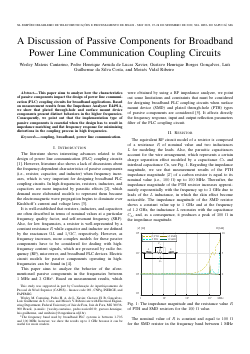
A Discussion of Passive Components for Broadband Power Line Communication Coupling Circuits
Wesley Mateus Cantarino, Pedro Xavier, Gustavo Gonçalves, Luis Guilherme Costa, Moises Vidal Ribeiro
DOI: 10.14209/sbrt.2022.1570821891
Keywords: coupling broadband power line communication
Abstract
This paper aims to analyze how the characteristics of passive components impact the design of power line communication (PLC) coupling circuit for broadband applications. Based on a measurement results, we show that plated through-hole and surface mount device components present distinct behaviors in the higher frequencies. Consequently, we point out that the implementation type of passive components is particularly important when the design have to result in impedance matching and flat frequency response for minimizing distortions in the coupling process in high frequencies.Download

Effective Secrecy Throughput in PLC Systems Threatened by a Wireless Eavesdropper: A Practical Perspective
Álvaro G. S. Correia, Moises Vidal Ribeiro, Ândrei Camponogara
DOI: 10.14209/sbrt.2022.1570821902
Keywords: Physical Layer Security Wireless Communication Power Line Communication Effective Secrecy Throughput
Abstract
This paper advances the investigation of physical layer security of broadband and indoor power line communication (PLC) system when a malicious wireless communication (WLC) device tries to eavesdrop upon private messages exchanged between two PLC devices. To do so, numerical results related to the effective secrecy throughput and the corresponding wiretap code rates for distinct positions of the malicious WLC device are provided for three different frequency bands, 1.7-30 MHz, 1.7-50 MHz, and 1.7-86 MHz under the power masks defined by the IEEE 1901 13-29 and ITU-T G.9964 standards.Download
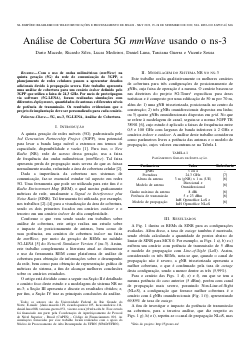
Análise de Cobertura 5G mmWave usando o ns-3
Dario Macedo, Ricardo Q. de F. H. Silva, Lucas I. C. Medeiros, Daniel R. de Luna, Tarciana Cabral de Brito Guerra, Vicente A. de Sousa Jr.
DOI: 10.14209/sbrt.2022.1570821912
Keywords: 5G ns-3 5G-LENA Análise de Cobertura
Abstract
Com o uso de ondas milimétricas (mmWave) na quinta geração (5G) da rede de comunicação do 3GPP, o planejamento de redes celulares passou a apresentar desafios adicionais devido à propagação severa. Este trabalho apresenta uma análise de cobertura para um cenário indoor definido pelo 3GPP que utiliza a faixa de 24,3 GHz. Por meio de prototipagem via software (5G-LENA), foram realizadas simulações com diferentes deployments, quantidades de antenas e diferentes níveis de potência de transmissão. Os resultados evidenciam que o projeto de implantação deve ser personalizado para cada cenário.Download

Adaptive Filter Theory and Application for the Identification of Sparse Systems
Cyro S. Hemsi
DOI: 10.14209/sbrt.2022.1570821925
Keywords: Adaptive Filters Sparsity System Identification
Abstract
One of the most popular adaptive algorithms available is the stochastic gradient algorithm, particularly a very simple implementation known as the least-mean-square (LMS) algorithm. Initially, this work offers a concise review of the adaptive filter (AF) theory, including sparse techniques. We then focused on identifying sparse channels, as is often the case in telecommunications and acoustics applications. In this case, conventional AFs, such as the LMS do not exploit prior knowledge of sparsity, therefore, sparse AFs have been shown to be more advantageous. This paper proposes sparse LMS-based AFs, derived from a simple approximation of the l_0-pseudo-norm penalty. These filters have low computational cost and are able to take advantage of channel sparsity, both to accelerate the convergence of estimates and improve the filter performance. Finally, the performance of the proposed methods is numerically validated by comparing them with well-known AFs.Download
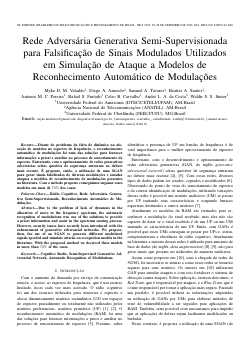
Rede Adversária Generativa Semi-Supervisionada para Falsificação de Sinais Modulados Utilizados em Simulação de Ataque a Modelos de Reconhecimento Automático de Modulações
Waldir Silva, André L. A. Costa, Antonio M. C. Pereira, Samuel Tavares, Celso Barbosa Carvalho, Diego A. Amoedo, Myke D. M. Valadão, Beatriz Alves dos Santos
DOI: 10.14209/sbrt.2022.1570822071
Keywords:
Abstract
Diante do problema da falta de dinâmica na alocação de usuários no espectro de frequência, o reconhecimento automático de modulações foi uma das soluções para fornecer informações a priori e auxiliar no processo de sensoriamento de espectro. Entretanto, com o aprimoramento de redes generativas adversárias sérias questões de segurança entraram no debate mais recente. Propomos, então, a utilização de uma SGAN para gerar sinais falsificados de diversas modulações e simular ataques a modelos de reconhecimento de modulações presentes na literatura. Com o método proposto conseguimos enganar esses modelos em mais de 70% dos casos.Download
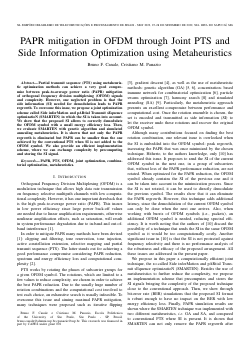
PAPR mitigation in OFDM through Joint PTS and Side Information Optimization using Metaheuristics
Bruno F. Canale, Cristiano M. Panazio
DOI: 10.14209/sbrt.2022.1570822199
Keywords: peak-to-average power ratio combinatorial optimization OFDM metaheuristics
Abstract
Partial transmit sequence (PTS) using metaheuristic optimization methods can achieve a very good compromise between peak-to-average power ratio (PAPR) mitigation of orthogonal frequency division multiplexing (OFDM) signals and complexity. However, one neglected problem is that the side information (SI) needed for demodulation leads to PAPR regrowth. To overcome this issue, we propose a joint optimization scheme called Side inforMation and pARtial Transmit sEquence optimizatioN (SMARTEN) in which the SI is taken into account. We show that the proposed SI allows to correctly demodulate the OFDM symbol with a small energy efficiency loss. Then, we evaluate SMARTEN with genetic algorithm and simulated annealing metaheuristics and it is shown through simulations that not only the PAPR regrowth is eliminated but PAPR can be smaller than the one achieved by the conventional PTS when SI is not added to the OFDM symbol. We also provide an efficient implementation scheme, where we can exchange complexity by precomputing and storing the SI signal.Download
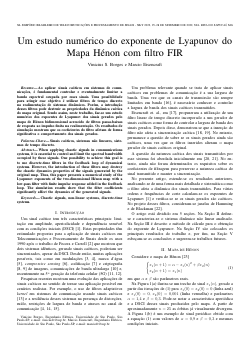
Um estudo numérico do exponente de Lyapunov do Mapa Hénon com filtro FIR
Vinicius Silva Borges, Marcio Eisencraft
DOI: 10.14209/sbrt.2022.1570822237
Keywords: Chaotic signals Non-linear systems Discrete-time systems
Abstract
When applying chaotic signals in communications systems it is essential to control and eventually limit the spectral band occupied by these signals. One possibility to achieve this goal is to use discrete-time filters in the feedback loop of dynamical systems. However, the introduction of these filters can destroy the properties of the chaotic dynamics of the signals generated by the original map. Thus, this paper presents a numerical study of the Lyapunov exponents of the signals generated by the two-dimensional Hénon map with low-pass finite impulse response filters added in the feedback loop. The simulation results show that the filter coefficients significantly affect the behavior of the generated signals.Download

Robust Power Allocation and Precoding for Cell-Free and Multi-Cell Massive MIMO Systems
Erick Freitas de Almeida, Rodrigo C. de Lamare
DOI: 10.14209/sbrt.2022.1570822287
Keywords: massive MIMO cell-free systems precoding power allocation
Abstract
Multi-Cell (MC) systems are present in mobile network operations from the first generation to the fifth generation of wireless networks, and considers the signals of all users to a base station (BS) centered in a cell. Cell-Free (CF) systems works with a large number of distributed antennas serving users at the same time. In this context, Multiple-input multiple-output (MIMO) techniques are used in both topologies and result in performance gains and interference reduction. In order to achieve the benefits mentioned, proper precoder design and power allocation techniques are required in the downlink (DL). In general, DL schemes assume perfect channel state information at the transmitter (CSIT), which is not realistic. This paper studies MC and CF with MIMO systems equipped with linear precoders in the DL and proposes an adaptive algorithm to allocate power in the presence of imperfect CSIT. The proposed robust adaptive power allocation outperforms standard adaptive and uniform power allocation. Simulations also compare the performance of both systems frameworks using MMSE precoders with robust adaptive power allocation and adaptive power allocation.Download
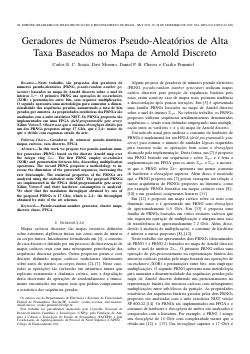
Geradores de Números Pseudo-Aleatórios de Alta Taxa Baseados no Mapa de Arnold Discreto
Carlos Eduardo Correia de Souza, Davi C. M. de Almeida, Daniel P B Chaves, Cecilio Pimentel
DOI: 10.14209/sbrt.2022.1570822540
Keywords: Geradores de números pseudo-aleatórios Mapas caóticos Caos discreto FPGA
Abstract
In this work we propose two pseudo-random number generators (PRNG) based on the discrete Arnold map over the integer ring Z2^m. The first PRNG employ or-exclusive (XOR) and permutation between bits, discarding multiplication operations. The second PRNG proposes a methodology to increase the dimension of the generated sequences, increasing the rate bits/sample. The statistical properties of the PRNGs are analyzed using the statistical suite NIST. The proposed PRNGs are implemented in the FPGA (field-programmable gate array) Xilinx Virtex-5 and their hardware consumption is analyzed. We show that the maximum throughput obtained by one of the proposed PRNGs is 17 Gb/s, which is 2,4x the throughput obtained by state of the art schemes.Download